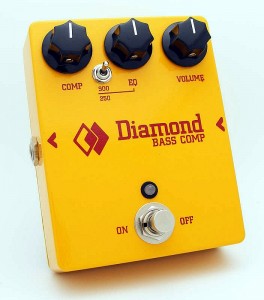Pedal Review: Diamond Bass Comp
Delicious Audio recently reviewed the Bass Comp stompbox by Diamond Pedals. Read below for a taste and click through to Delicious for the full review.
Diamond Pedals of Nova Scotia have been making guitar stompboxes for quite a while now. With the Bass Comp, they bring to bass players the high-grade optical compression previously available to guitarists in their Compressor pedal.
What’s in the box? Aside from the Bass Comp, there’s an 18 volt DC power supply, a short, red, power-polarity-reverse cable (more on that later), and a well written, useful, four page manual.
The Bass Comp accepts between 9 and 24 Volts DC, and cannot be battery powered. The included 18VDC adapter provides the recommended operating voltage. Running at twice typical stompbox voltage allows the Bass Comp greater headroom, and should make it play nicer with high output active instruments. Note the pedal power jack is negative ground/ positive tip — if powering via a standard 9VDC adapter, use the included polarity reversal cable.
The build quality of the Bass Comp is excellent. A genuine Hammond cast-aluminum enclosure houses real Switchcraft jacks, Alpha pots, Vactrol opto-isolator, Analog Devices op amp and a slew of discrete transistors. The PCB is very cleanly laid out, and a solid feeling 3PDT switch handles true bypass duties. Inside are two hidden controls: a bypass switch for the EQ, and a hi-cut jumper. In testing with a single 12” bass speaker, I could hear a very subtle difference in the background noise engaging and disengaging the EQ switch, but no difference at all engaging the hi-cut. It may be the lack of perceptible difference was due to the test bass cab lacking a tweeter.
On top of the pedal are knobs for Compression (COMP), EQ, and output volume (VOL). A small toggle selects the pivot point for the EQ, and a dual-color LED indicates that the compressor is engaged (green), and that compression is happening (orange to red, depending on the amount of compression).
Click thru to Delicious Audio for the rest of this review, by Ron Guensche.







